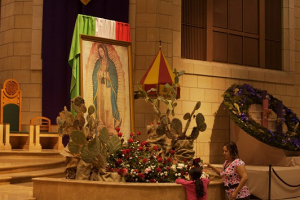page 298: Guadalupe Roncal mentions that she drinks a Sonoran drink called bacanora. This is essentially mezcal made from the agave plants in the state of Sonora. The distillation process is slightly different since the drink was exclusively made by bootleggers until 1992 when it was legalized in Mexico. The main difference involves the way the agave heads (or pinas) are roasted. Sounds much better than pulque!
page 303: Fate and the hotel clerk have an intense discussion about clouds. It just so happens that Fate knows the Greek root of the word cirrus? I thought briefly that this this hotel clerk reminded me of Tim Roth as the hotel clerk in Four Rooms.
page 307: Fate is watching the undercard: a fighter in white shorts versus a fighter wearing “black, purple, and red striped” shorts. This is when he hears his name being called, but can’t see who’s talking to him. Two pages earlier, Fate is at a restaurant that includes a foosball table at the back. One team of the players/figures on the foosball table wear white shorts and the other team wears black/red outfits. The black/red team has small devil horns on their foreheads. When Oscar first heard his name being called in the crowded arena, I was still thinking of Oscar-as-Jonah and that this voice calling him was maybe the devil, tempting him to stay in Santa Teresa. Fate is called over to Chucho and Rosa and Rosita and Charly Cruz and his meandering journey through the underbelly of Santa Teresa takes off from there. (As a side note, we all know that the color red is traditionally associated with representations of the devil, but did you know that so are stripes? Stripes are the devil’s cloth!)
page 317: It someone’s birthday and the Mexicans start to sing Las Mañanitas (Little Mornings), the traditional Mexican birthday song. Fate asks Rosa Amalfitano what’s the connection between King David and birthdays. She doesn’t know because she’s from Spain. The first line of the song is Estas son las mañanitas, que cantaba el Rey David (roughly: This is the morning song that King David used to sing). David was the psalmist and is known for those psalms as songs, so that part’s not that unusual (especially in a mostly Catholic country). But what’s interesting is that Las Mañanitas is also sung at novenas celebrating patron saints—and is traditionally sung to meet the Virgin of Guadalupe on the morning of her feast day:
page 333: Amalfitano mentions “Professor Plateau.” Some googling reveals him to be an interesting character, but I can’t gather much information together about him. Anyone have a historical sketch or more details about him? The “rapid succession of fixed images” described in relation to the zoetrope/moving image calls to mind the dreamer back on page 300 who’s “dreaming at great speed” and thus a connection between dreams and movies.
page 335: Rosa Amalfitano is in the coffee shop reading a book on Mexican painting in the twentieth century and begins to read a chapter on Paalen. This is Wolfgang Paalen, who was born in Austria and grew up in Germany, Italy, and Paris and later moved to Mexico (at the invitation of Frida Kahlo). He’s associated with the surrealists of the period (including Marcel Duchamp). I think a Paalen would make a fine cover image for 2666:


